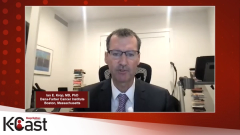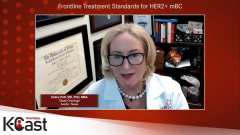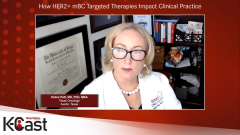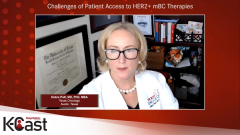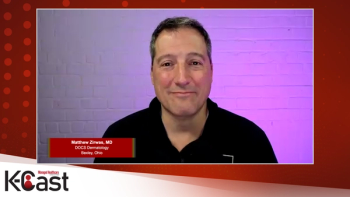
Frontline Treatment Options for HER2+ Metastatic Breast Cancer
Frontline therapies available for newly diagnosed HER2-positive metastatic breast cancer and variables that impact treatment selection.
Episodes in this series

Briana Contreras: Welcome to this Managed Healthcare Executive® K-Cast program titled, “Value-Based Decision-Making in Metastatic Breast Cancer.” I’m Brianna Contreras, associate editor of Managed Healthcare Executive®. Joining us today is Dr Ian Krop, oncologist and associate professor of medicine at the Dana-Farber Cancer Institute in Boston, Massachusetts.
Dr Krop, in our first series of questions, we’ll be reviewing the first-line standard of care treatment of HER2-positive metastatic breast cancer. What has been the historical frontline standard of care for HER2+ metastatic breast cancer?
Ian E. Krop, MD, PhD: For about the last 20 years, we’ve been using the combination of chemotherapy and HER2 therapy for patients with newly diagnosed metastatic HER2+ breast cancer. That was based on this realization that the reason these HER2+ breast cancers were having such bad outcomes when treated with chemotherapy alone was that HER2 overexpression was making these cancers grow more aggressively and be resistant to standard therapies like chemotherapy. That led to the introduction of the first HER2 therapy, which was trastuzumab, and it was shown in a large randomized trial that adding trastuzumab to chemotherapy led to significant improvements in outcomes compared to chemotherapy alone. Since then, we have built upon that by using HER2 therapies in multiple lines of treatment for these patients. Specifically for the first-line setting, we now use chemotherapy for most patients, and we can talk more later about whether we should be using chemotherapy in every patient. But we use chemotherapy, typically a taxane, either paclitaxel or docetaxel, in combination with trastuzumab. There are now more recent data showing that dual HER2 therapies, combining chemotherapy with trastuzumab and another monoclonal antibody against HER2, pertuzumab, lead to even better outcomes than just trastuzumab and chemotherapy alone. For most of our patients these days with newly diagnosed HER2+ disease, we start out with a taxane, trastuzumab, and pertuzumab.
Briana Contreras: Thank you. How do you decide which patients are appropriate for chemotherapy in this setting, and what do the NCCN [National Comprehensive Cancer Network] guidelines recommend?
Ian E. Krop, MD, PhD: As I said, I think in practice, most of our patients will get chemotherapy in the first line of therapy, along with trastuzumab and pertuzumab. But there are alternatives to that. There have been studies showing that endocrine therapy, with either trastuzumab or with trastuzumab and pertuzumab, or even with a tyrosine kinase inhibitor, like lapatinib, also has reasonable levels of activity when used in that first-line setting. There are alternatives. I guess the question is, how do you decide which one to use? But we do have data that either using chemotherapy with HER2 therapy or endocrine therapy with HER2 therapy in the first line is an effective option.
Briana Contreras: Thank you. What are some of the challenges associated with available frontline therapies for providers and for patients?
Ian E. Krop, MD, PhD: Some of the challenges are deciding who benefits from using upfront chemotherapy versus who benefits from one of these alternative therapies. If you look at the NCCN guidelines, they’re not very directive; they say you can use either approach. I think in practice, what we do is use the chemotherapy for most patients because that’s where there’s been clear demonstration of a substantial survival benefit. But as I said, there are also trials looking at endocrine therapy with HER2 therapy. I think what most of us do is take into account patient preferences, patient characteristics, to try to decide who we can avoid using chemotherapy with, at least in that first-line initial treatment. Some of the characteristics that we think about are the patient’s age and performance status, meaning how well they’re likely to tolerate chemotherapy, and also how much disease burden they have. For instance, an older patient with a lot of comorbidities, who you worry will have substantial toxicity from chemotherapy, that would be a patient for whom you may consider holding off on chemotherapy, and using endocrine therapy and HER2 therapy alone.
I must say when I’m talking about using endocrine therapy, I’m only talking about that in those patients who have estrogen receptor-positive, HER2+ breast cancer, which makes up a little bit more than probably 50% of HER2+ disease. For those patients who are hormone receptor-negative and HER2+, we can’t use endocrine therapy, but on occasion, you can use HER2 therapies alone in that population. But for a patient who is hormone receptor-positive and HER2+, that patient is a candidate for using endocrine therapy with HER2 therapy. Again, the things we would think about are those patients who are older, have a lot of comorbidities, and may not do as well with chemotherapy, and patients who have a very low burden of disease. For example, a patient who has metastatic disease by virtue of an incidentally discovered bone metastasis, and who’s asymptomatic, doing very well, and just was found to have metastatic disease on a scan. In that patient, who’s asymptomatic, you’re not going to improve their quality of life by giving them therapy because their quality of life is fine. All you can do is potentially worsen than their quality of life, at least in the short term. You’d love to be able to control their disease so it doesn’t become symptomatic for as long as possible, but you also don’t want to saddle them with a bunch of toxicities from your therapy.
In that patient population, who has a very small burden of disease, is asymptomatic, and/or you don’t think is going to tolerate chemotherapy, that’s the patient population for which I’m much more comfortable giving endocrine therapy, plus either trastuzumab or trastuzumab plus pertuzumab, as a way to stave off having to jump to chemotherapy.
Transcript edited for clarity.
Newsletter
Get the latest industry news, event updates, and more from Managed healthcare Executive.

